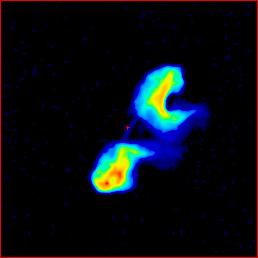 Image:
Image:3C 28 | B0053+261 |
| S178 | Alpha | FR | Class | ID | Spectrum | Best z | mag. | LAS | lg P178 | D |
|---|---|---|---|---|---|---|---|---|---|---|
| 17.8 | 1.06 | II | RD | Gal | 0.1971 | R(c) = 16.84 | 45.60 | 26.06 | 127.0 |

| Size: | 76.8 × 76.8 arcsec² |
|---|---|
| LUT: | Linear |
| Beam: | 1.1 arcsec |
| Frequency: | 1424 MHz |
| Method: | VTESS Õ˜ÿ>1.1
|
| Telescope: | VLA A+B |
| Credits: | This Atlas, Feretti et al. (1984) |
The radio structure is a prototypical "relaxed double", lacking bright compact structure in the lobes. Our image shows for the first time a very faint and narrow filament crossing the gap between the lobes, and passing (to within the uncertainties) through the position of the galaxy nucleus (marked here with a red cross). There is no sign of a break at the nucleus, nor is there a brightening that could be interpreted as a compact core. The structure could be either a pair of twin jets or a filament of the kind found between the lobes in 3C 338 and 3C 442A.
3C 28 is at the peak of the X-ray emission of its sub-cluster, and the high-resolution X-ray image of Feretti et al (1984) shows that the hot gas peaks between the two lobes and is elongated perpendicular to the radio axis. Feretti et al. show that the gas is probably a cooling flow core, with ample pressure to confine the radio lobes. It seems likely that the distorted tails of the lobes are bending to follow the pressure gradient away from the galaxy and cluster centre.
The radio spectrum is very steep at high frequencies; the spectral index averages nearly 2 and reaches nearly 3 in the tails (Macklin 1983, Giovannini, Feretti & Gregorini 1987). This is not unusual for DRAGNs in cluster centres. The single-dish fluxes at 1.4 GHz and above listed on our Data Page appear to be substantially too high and may be affected by confusion with another cluster radio galaxy 4 arcmin to the NE.
The depolarization wavelength of 31 cm recorded by Strom & Conway (1985) also appears to be in error. No polarization at all is detected at 21 cm, and the peak polarization of 9% at 6 cm (Giovannini et al.) is low enough to suggest that substantial depolarization has already set in. This would imply Rotation Measures > 200 rad/m², making the Faraday rotation of 3C 28 comperable to those of other DRAGNs in cluster centres (e.g. Taylor, Barton & Ge 1994).
Our image is based on VLA A-configuration data obtained for the
atlas, combined with the B-configuration data of
Feretti et al (1984).
| Prev. | Data Page | Other images | Next | Search | Alphanumeric List | Icon List | Atlas Index |
|---|